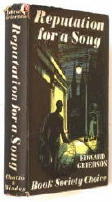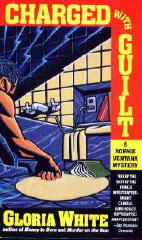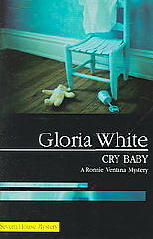December 2008
Monthly Archive
Mon 22 Dec 2008
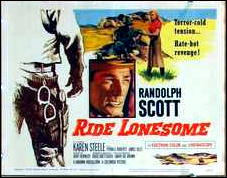 RIDE LONESOME. Columbia Pictures, 1959. Randolph Scott, Karen Steele, Pernell Roberts, James Best, Lee Van Cleef, James Coburn. Screenwriter: Burt Kennedy; director: Budd Boetticher.
RIDE LONESOME. Columbia Pictures, 1959. Randolph Scott, Karen Steele, Pernell Roberts, James Best, Lee Van Cleef, James Coburn. Screenwriter: Burt Kennedy; director: Budd Boetticher.
When I was but a lad, Randolph Scott’s westerns were among my favorites, but I always wondered why he always played somebody different every time one of his movies came to town.
Roy was always Roy, Gene was always Gene, and Durango was always Durango (but his alter ego Steve always seemed to have a different last name, a sneaky fact I never realized until IMDB came along).
Having a cowboy star named Steve was all I needed, nothing more.
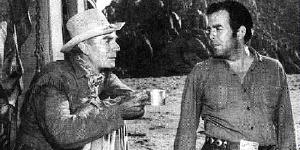
I never saw Randolph Scott’s later westerns, though. By the time the late 50s came along, I was interested in other things, and it’s only recently that I’ve discovered that the later ones are considered to be among his best.
I suspect that many of you are way ahead of me on this.
In Ride Lonesome, for example, he plays a lean and somewhat mean bounty hunter named Ben Brigade. His prisoner is a young outlaw (and killer) named Billy John, played to callow perfection by James Best. Also on Billy John’s trail, but arriving too late are a couple of other outlaws (Pernell Roberts, in his pre-Bonanza days, and James Coburn, whose film debut this movie was).
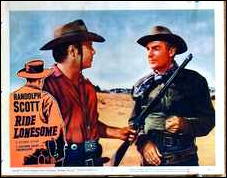
The reward money is not what motivates these last two. It’s the amnesty that the governor of the state has promised to anyone who brings Billy John in. Reluctantly they team up with Brigade, though, to make a stand against of a marauding band of Indians who have already killed Carrie Lane’s husband, manager of a stage stop in almost the middle of nowhere.
That makes five of them who, once the Indian threat has passed, must also reckon with the fact that Billy John’s brother (Lee Van Cleef) is not going to take lightly the prospect of his hanging. As Ben Brigade, Scott is laconic to the point of barely moving his lips, his aging features chiseled as if out of well-weathered stone.
A couple of segments of dialogue will illustrate, courtesy of IMDB to get them correct, but they’re the same ones that caught my ear as I was watching:
Billy John: Brigade, whatever they’re payin’ you, its not enough. Not nearly enough.
Ben Brigade: I’d hunt you free.
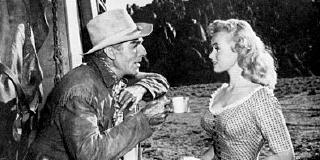
Mrs. Carrie Lane: You don’t seem like the kind that would hunt a man for money.
Ben Brigade: I am.
I see that I have not yet mentioned Karen Steele, the young and impossibly blonde actress who plays Mrs. Lane, and she of the statuesque figure with measurements that even Barbie could envy. (Most of Karen Steele’s career seems to have been on television; this is one of only a very few movies she made. I truly regret not having a color closeup photo to show you.)
Not surprisingly, Brigade’s temporary allies eye her with lust in their eyes as well as their heart, and even Brigade himself seems to be susceptible to her charms, once or twice. But Billy John is not Brigade’s only mission, and as the title suggests, it’s a lonesome one.
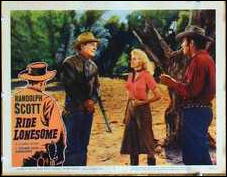
In the list of my all time favorite western movies, I’m thinking it over, but I’m not yet sure that this one’s on it, or that it should be. Other reviewers have praised it highly, but at just over 70 minutes long, the story’s not quite deep enough for me to be convinced. But what it is is extremely good. The color photography is terrific, and all of the actors involved do top notch jobs.
I don’t know why I’m resisting. But as I was watching, the story didn’t quite feel real enough, a little stagey perhaps, or maybe a little too pat for its own good. But as I’m writing this, I’ll tell you what. The movie’s calling me to watch it again, and there’s no way I won’t.
Not only that, but I have a feeling that when I do, it’s going to move up a few notches in my own but totally objective personal ranking.
Mon 22 Dec 2008
Posted by Steve under
Reviews1 Comment
BEN SLOANE – Hot Zone.
Gold Eagle; paperback original. First printing, March 1990.
As they would say in the world of comic fandom, this is Max Horn’s origin as a superhero. What he is is a cop in 21st century New York who, after getting augmented parts (a la the Six Million Dollar Man), goes out to wreck havoc (and revenge) in a city so decayed and dying it looks as though Mad Max had been living there for years.
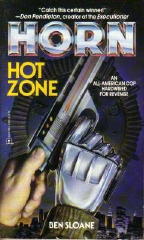
Since the book takes place that far in the future, he even goes out into space, and most of the action takes place on a mining asteroid called New Pittsburgh. I’ve seen only bits and pieces of the movie Total Recall, but on the basis of the little I’ve seen, I think they could use the same background sets in making a film of Hot Zone. (To give Mr. Sloane (a pen name) some credit, maybe the book came first. (Or did Robocop?))
There are some moments of rather sardonic humor in Hot Zone, but mostly what this book is about is violence and killing and body parts scattered all over the place (as in all of the other action/adventure books that Gold Eagle publishes).
If you are not up to it, this is 300 pages of sludge. Books like this do sell, however, and they are direct descendants of certain superhero pulps of the 30s and 40s. If you enjoy those, I think you might like this book, too.
I didn’t much care for it, though. What I find objectionable in stories of this sort is the underlying contempt there seems to be for human life. The descriptive scenes are well done (those not involving murder and mayhem), and I can’t deny that there’s plenty of raw power in the telling.
But the dialogue is exceedingly poor (“holy shit” being the most common phrase some of the characters can manage to come up with), and there’s just no getting around it, plain and simple, this is a terribly grim view of life.
Let’s put it this way. I felt as though I needed to take a shower when I was done. I probably don’t know you well enough to be able to say for sure, but you may feel that way too.
— Reprinted from Mystery*File 33, Sept 1991 (greatly revised).
[UPDATE] 12-22-08. When I say “greatly revised” I don’t mean to suggest that I changed any of the essence of the review. A lead-in paragraph was deleted, I changed the order of some of the original phrasing, and I rewrote the last line. (I have no reason to doubt the sincerity of my opinion as it wrote it then, as opposed to now.)
Since I brought it up, I thought I’d do some investigating. Mad Max came out in 1979; Robocop in 1987; and Total Recall premiered in June 1990. This makes the latter too late to be a source, but not the other two.
As for Ben Sloan and the “Max Horn” series, there were only four. Perhaps books like these stopped selling, or perhaps the general consensus of the intended reading public ran along the same lines as mine. In the spirit of full disclosure, though, here are the titles, taken from the Revised Crime Fiction IV, by Allen J. Hubin.
From which I have also learned the true name of the author; Mr. Hubin lists no other titles to his credit.
SLOANE, BEN. Pseudonym of Stephen R. Cox.
Hot Zone. Gold Eagle, pbo, 1990.
Blown Dead. Gold Eagle, pbo, 1990.
Outland Strip. Gold Eagle, pbo, 1991.
Ultimate Weapon. Gold Eagle, pbo, 1991.
Sun 21 Dec 2008
RIVER OF NO RETURN. 20th Century Fox. Robert Mitchum, Marilyn Monroe, Rory Calhoun, Tommy Rettig. Director: Otto Preminger.
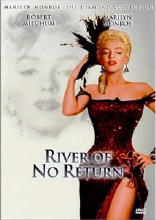
I’ve listed only four cast members, but the opening scenes take place at a tent city swarming with prospectors, would-be prospectors, and those who prey on them, not to mention dance-hall girls and other members of the fairer sex, some innocent, others not so, and for almost all of time, their parts are so small I didn’t bother listing their names. (You can find them at IMDB if you’re so interested.)
All we really see for the longest part of three-fourths of the film are (in remarkably the same proportion) only three of the four above.
There are some Indians, though, and they’re howling down the trail of Matt Calder (Robert Mitchum), who’s trying to make a life for himself as a farmer; his nine-year-old son Mark (Tommy Rettig of Lassie fame); and Kay Weston (Marilyn Monroe), one of those previously mentioned dance-hall girls, complete with sequins, black net stockings, and a guitar.
Forced onto a raft to make their escape, the trip downriver is hard and torturous. They’re without a horse or a rifle, both stolen by Kay’s no-good husband Harry, one of those previous mentioned gamblers. (This is where the perfectly cast Rory Calhoun comes in.) As a parenthetical remark, I believe that Kay says toward the end of the movie that they aren’t married yet, but once Harry files his claim on a gold mine he won in a poker game, they intend to.
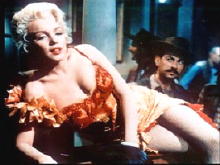
Of course close propinquity makes all the difference in the world, although the road to romance is never easy, and so it is here. In a pique of anger, Kay blurts out Matt’s secret, which causes a rift between him and his son, which makes a group of not very happy camping buddies for a while.
A scene in which Matt cannot resist temptation and tries to kiss Kay, who is not particularly receptive at the time, comes surprisingly close to a rape scene, one that must have barely gotten by the censors.
That Matt tosses Kay over his shoulder at the end seems to be an all-but-foregone conclusion throughout the movie, but if it were filmed today, I don’t think that scene would be included – unless for a comic effect that would otherwise not be called for.
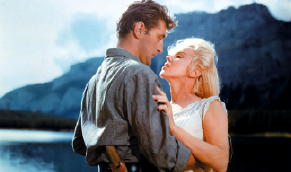
As for the two stars, Marilyn I don’t believe was ever lovelier, and nothing I could say could be more direct or emphatic than that. She may even have done her own singing in this movie, but I am kind of doubtful about the guitar playing.
Robert Mitchum plays himself and second fiddle very nicely, in a role of a new father (to a son he’s only learning to know) in which he’s almost perfect, but not quite.
As to the future to this new family (hopefully not giving too much away), some viewers may wonder how easily Kay may adjust to her new life. I suppose answering this question might have paved the way for another movie, a sequel, but on the other hand, why spoil the ending of this one?
PostScript. I understand that the making of this movie was not easy, to say the least. Preferring to concentrate on the end results, I didn’t go into any of that in my comments above. I thought I should add this short paragraph here at the end, though, just so that you’d know I wasn’t totally unaware of the real world.
[UPDATE] 12-22-08. There’s one thing I forgot to mention. The movie was filmed in CinemaScope or the equivalent, but the Cinemax channel that I taped it from definitely did not show a wide-screen version. Every so often, and too often as far as I was concerned, all we see of two people talking to each other in the same shot are their noses — and a wide expanse of countryside in between, or a close-up shot of a piano player busily working away behind them.
I’ve just ordered what ought to be a much improved version on DVD from Amazon. Countrysides are nice, and the piano player is really quite terrific, but I’d really prefer to see the primary actors.
Sun 21 Dec 2008
Whoever it is in New England who’s dreaming of a White Christmas, would somebody wake him or her up?
Eight inches of snow on Friday, impossible roads yesterday, and six more inches today. Come on. Enough is enough.
But other than that, and a certain cooped up feeling, all is fine here, and I hope it is where you are, too.
Happy holidays, everyone!
—Steve
Sun 21 Dec 2008
THE MUMMY. Universal, 1932. Boris Karloff, Zita Johann, David Manners, Arthur Byron, Edward Van Sloan, Bramwell Fletcher. Director: Karl Freund.
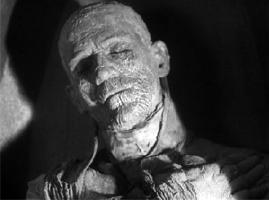
I don’t suppose you’ve been waiting for me to review this movie before you decide to see it or not. It’s one the classics, that’s for sure, and yes, I saw this back when I was a young lad, around 10 or so, and it scared me something awful back then, but not as much as the kid from school sitting next to me — no, wait. That was Frankenstein, which I think was even scarier. I know the other kid from school thought so! I don’t remember ever seeing Dracula, though, even now.
Today — returning as I should to The Mummy — I don’t think kids of 10 will be scared by this movie at all, having grown up on video games and movies rated R that they’ve managed to get in to see, or even PG-13, with all of the special effects and blood and gore.
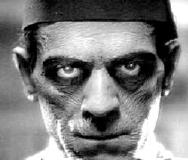
No blood and gore in this one, if I remember it correctly, and I just finished watching it not more than 10 minutes ago. It’s all in the mind. Special effects? Well, the bandaging job on the mummy was spot on. First, in the present day — when his tomb is opened, the inscription that awakens him is unwittingly read, and the mummy strolls out leaving shreds of unraveled cloth behind. (I must have only imagined the musty smell.)
But even more vivid, to me, was the flashback scene taking place in the far distant past, when Im-ho-tep was first wrapped up in them from head to toe — and buried alive. Br-R-r-r-r. I think that this, the burial scene, gave me more chills than anything else in the movie. Some people seem to remember the the reawakening as what scared them the most, and while I don’t agree, I certainly don’t blame them.
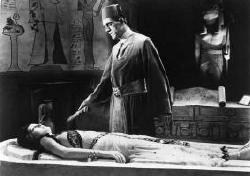
All in all, I don’t think The Mummy is as much of a horror movie than one based on the occult or reincarnation: the spirit of Princess Anck-es-en-Amon now resides in the physical body of Helen Grosvenor, played by the very bewitching Zita Johann in her own right.
A movie based on either of these ideas would have been spooky enough in the 1930s without needing much in the way of extra trappings, or to a ten-year-old boy on a re-release some 20 years later.
Sat 20 Dec 2008
Posted by Steve under
ReviewsNo Comments
THE CURMUDGEON IN THE CORNER
by William R. Loeser
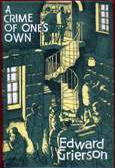
EDWARD GRIERSON – A Crime of One’s Own. Chatto & Windus, UK, hardcover, 1967 (shown). G. P. Putnam’s Sons, US, hc, 1967. US paperback reprint: Berkley Berkley X1681, 1969.
The setting for Edward Grierson’s A Crime of One’s Own is a busy, comfortable English provincial book shop. The owner, Donald Maitland, lets his imagination and curiosity get the best of him by coming to the conclusion that spies are responsible for the defacement of books and other strange happenings in his lending library.
His early bumbling attempts to investigate and gradually decreasing remissions of sanity are humorous, but, midway in the book, he illegally enters the apartment of a girl he suspects of being a courier, is almost discovered, and is promptly arrested for her murder, which occurs later that night, by stabbing with his letter opener.
Now Grierson has really gotten his hero and himself in the soup, and a series of delicate courtroom scenes of Donald’s trial, done in the manner of Henry Cecil, only delay the time when the unconvincing real spies have to be dragged out in order to get author and hero off the hook.
The book shop, its employees and customers are well done.
– From The MYSTERY FANcier, Vol. 3, No. 4, July-Aug 1979 (very slightly revised).
Bibliographic data:
Says Wikipedia of the author: “Edward Grierson (9 March, 1914 – 1975) was a Northumberland barrister and a writer of crime novels. His debut crime novel is the outstanding Reputation for a Song, a classic Inverted detective story.”
Also the author of several works of historical fiction and non-fiction, Grierson wrote only four mystery novels. From the Revised Crime Fiction IV, by Allen J. Hubin, here’s a complete list:
Reputation for a Song. Chatto, UK, 1952. Knopf, US, 1953. Film: MGM, 1970, as My Lover, My Son (scw: William Marchant, Jenni Hall, Brian Degas, Tudor Gates; dir: John Newland).
The Second Man. Chatto, UK, 1956. Knopf, US, 1956.
The Massingham Affair. Chatto, UK, 1962. Doubleday, US, 1963.
A Crime of One’s Own, Chatto, 1967. Putnam, US, 1967.
Sat 20 Dec 2008
GLORIA WHITE – Murder on the Run.
Dell, paperback original. First printing, July 1991.
According to page one, Ronnie Ventana is the half-Mexican daughter of a pair of jewel thieves. Somehow she is now a PI. According the short bio at the end of the book, this is Gloria White’s first novel.
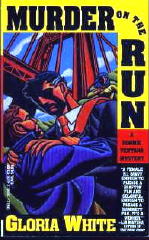
Of these two statements, the first one is more than a little unusual, but it’s actually the second one that’s harder to believe. This is a very good book, and if I had any say in the matter (which I don’t, since I’m not involved in voting for any book for any award) I think it could easily be nominated for Best First Novel in anybody’s league.
It begins like this. Ronnie is out running near Golden Gate Bridge one morning, when she spots two men struggling. One pushes the other into the water, and then she is pursued by the one who did the pushing. Luckily she gets away.
Two problems follow right away: (1) the body is not discovered immediately, and (2) she recognizes the person who did the dumping as Pete August, a PI who once worked for the D.A.’s office, and who was also once on the police department — and in brief, a fair-headed, high profile boy with all his former connections still intact.
Snubbed by the police, Ronnie keeps on the case. More deaths follow, and she manages to get a homicide detective named Philly Post interested. Ronnie is a lady who doesn’t give up, and the story has both ginger and snap.
There is even an unexpected twist ahead. The only problem is the ending. It’s too predictable. A little too obvious. I saw it caning. One good twist deserves another, as the saying goes, and I didn’t get it.
Don’t get me wrong, though. This book is as good as any of the other female PI novels I’ve read in recent months, and some of them were as good as some of the males of the species. (A number of them were even better.)
— Reprinted from Mystery*File 33, Sept 1991 (slightly revised).
[UPDATE] 12-20-08. This is the first review I’ve reprinted since I announced the new focus for this blog posted last weekend but revised earlier today. I was doing movie reviews back in 1991 as well as now, and the ones in this old issue of M*F will soon be showing up here also.
As for Gloria White, her PI character Ronnie Ventana didn’t have as long a career as I was hoping when I wrote this review. In spite of a slew of award nominations, which I’m pleased to have anticipated, Dell dropped her books after only four outings. Luckily, and this doesn’t always happen, two more books in the series have come out in recent years, and in hardcover to boot.
Expanded from her entry in the Revised Crime Fiction IV, by Allen J. Hubin, here’s a list of all of Gloria White’s mystery fiction:
WHITE, GLORIA. Series character: PI Ronnie Ventana in all.
* Murder on the Run. Dell, pbo, 1991. [Anthony Award finalist]
* Money to Burn. Dell, pbo, 1993.
* Charged with Guilt. Dell, pbo, 1995. [Edgar Award Finalist, Shamus Award Nominee, Anthony Award Finalist]
* Sunset and Santiago. Dell, pbo. 1997. [Edgar Award Finalist, Shamus Award Finalist]
* Death Notes. Severn House, hc, April 2005.
* Cry Baby. Severn House, hc, June 2006; trade paperback, June 2007.
Fri 19 Dec 2008
More authors from the online Addenda for the Revised Crime Fiction IV, by Allen J. Hubin. What I had in mind was that the last grouping of such authors, also from the “C” section, was going to be the last I was going to be double-posting. But the extra exposure seems to help; the comments that were left were extremely useful.
So I’ve decided to continue posts like this one for a little while longer. Cutting down on the number of of authors will help. It’s quite a mixed batch this time around, as I think you’ll agree, about as different from each other as a group of five can get.
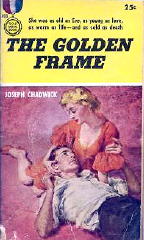
CHADWICK, JOSEPH L. Pseudonym: John Conway, q.v. Other pseudonyms: Joselyn Chadwick, Janet Conroy, Jo Anne Creighton, John Creighton and Elizabeth Grayson. Under his own name, the author of one crime novel included in the Revised Crime Fiction IV.
The Golden Frame. Gold Medal, pb, 1955. “She was as old as Eve, as young as love, as warm as life – and as cold as death.”
CONWAY, JOHN. Pseudonym of Joseph L. Chadwick, q.v. Under this pen name, the author of six titles published by Monarch as paperback originals between 1959 and 1961, including the one below. Besides one book in the Revised Crime Fiction IV under his own name, other titles appear under five additional pseudonyms.
A Sin in Time. Monarch, US, pb, 1961. Add setting: Pennsylvania. “She lived hard and fast until her sins caught up with her.”
CONYERS, (MINNIE) DOROTHEA (née BLOOD-SMYTH). 1863-1949. Born in Limerick, Ireland; married Lt. Conyers, who was killed in 1915, then married Captain White. Author of more than forty sporting novels and collections. Of these, seven of a criminous nature are included in the Revised Crime Fiction IV. Add the following:
Kicking Foxes. Hutchinson, UK, hc, 1947. Setting: England. A novel of the “changing fortunes of a lady in the Leicestershire hunting set.”
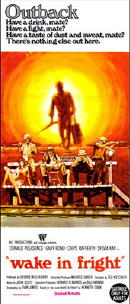
COOK, KENNETH.
Wake in Fright. Joseph, UK, hc, 1961; St. Martin’s, US, hc, 1962. Setting: Australia. Film: NLT, 1970; also released as Outback (scw: Evan Jones; dir: Ted Kotcheff). [Add alternative title.] “The story of John Grant, a young school teacher, stranded in a brutal and menacing town in outback Australia.” [Reputed to be Australia’s great lost film.]
COOK, ROBIN.
Acceptable Risk. TV movie: TBS, 2001 (scw: Michael J. Murray; dir: William A. Graham)
Harmful Intent. TV movie: David Schneider, 1993 (scw: James Steven Sadwith; dir: John Patterson)
Mortal Fear. TV movie: ACI, 1994 (scw: Rob Gilber, Roger Young; dir: Larry Shaw)
Outbreak. TV movie: NBC, 1995, as Virus; also released as Formula for Death (scw: Roger Young; dir: Armand Mastroianna)
Terminal. TV movie: NBC, 1996 (scw: Nancy Isaak; dir: Larry Elikann)
COOKE, L(AWRENCE) A(LFRED) B. Add/correct his first two names in full. Brother of mystery writer Rupert Croft-Cooke; educated at Oxford; tutor in Switzerland for two years; antiquarian bookseller; later prep school teacher. Author of a single title listed in the Revised Crime Fiction IV.
War in the Gates. Geoffery Bles, UK, hc, 1937. Setting: England. [Could the fascist movement in England have tried to impose a dictator on the UK Government?]
Fri 19 Dec 2008
Posted by Steve under
Reviews[3] Comments
A REVIEW BY MARY REED:
MILES BURTON – The Secret of High Eldersham. Collins, UK, hc, 1930. Mystery League, US, hc, 1931 (shown). Also published as The Mystery of High Eldersham, Collins, UK, pb, 1933 (also shown).
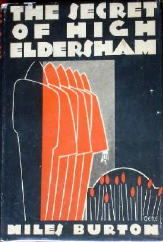
Retired Metropolitan Police sergeant Samuel Whitehead is landlord of the Rose and Crown public house in the East Anglian village of High Eldersham. Hitherto the pub has not been a paying concern but since Whitehead took over as mine host it has done well, despite the fact the locals are not the friendliest of folk and outsiders who take up residence in the village tend not to prosper.
Then late one evening village bobby Constable Viney finds Whitehead murdered in the pub. Given the till has not been rifled, it seems robbery was not involved. What then could the motive have been?
Chief Constable Bateman has hardly been on the scene five minutes, much less interviewed any of the villagers except Constable Viney, when he decides to call in Scotland Yard.
Enter Detective-Inspector Robert Young of the Yard. Taking up residence at the Rose and Crown next day, he soon senses there is something, well, odd about the village and writes to his friend Desmond Merrion asking him to come to High Eldersham to discuss the case.
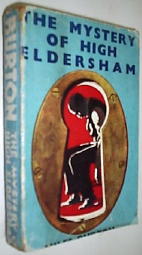
My verdict: Alas, I found this entry in the Merrion series less entertaining than some of his other adventures. One secret of High Eldersham will leap out at the alert reader a few chapters before it is revealed by the author and the other telegraphs itself in similar fashion. In all fairness it is possible these matters were considered much more shocking at the time the book was published than nowadays.
Questions such as the identity of the lady who shows up in the village in a Rolls Royce and why the publican was murdered and by whom are solved in a satisfactory manner, and there’s even romantic interest for Merrion.
While generally slow-paced there are several gripping episodes, but to avoid spoilers their nature had best remain shrouded in thick fog rather than trumpeted forth in this short review. On balance, then, if I had to assign a grade, I’d mark it as a B.
Etext: http://www.munseys.com/diskfour/helddex.htm
Fri 19 Dec 2008
LIBELED LADY. MGM, 1936. Jean Harlow, William Powell, Myrna Loy, Spencer Tracy, Walter Connolly. Screenplay: Maurine Watkins, Howard Emmett Rogers and George Oppenheimer. Director: Jack Conway.
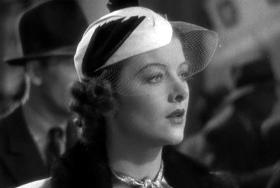
A movie with four lead stars in it was quite the thing in 1936, and it still is today, especially if the four stars are the first four listed just above. Jean Harlow, alas, was to make only two more movies after this one (or is it one and a half?). She died way too young – only 26 years old.
She was engaged to William Powell at the time of her death, but in the movies that seemingly semi-sozzled but always debonair leading man will be forever linked with the supremely beautiful Myrna Loy. One arched glance my way, if it were ever to have happened, would have made me putty in her hands, as it did audiences from her time to now.
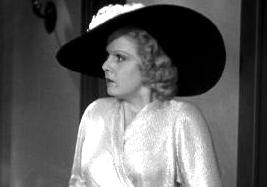
Spencer Tracy, as Haggerty, the beleaguered editor of the newspaper that jet set debutante Connie Allenbury (Loy) is suing for libel, is teamed up with Jean Harlow in this one.
Her role is that of Gladys, the girl he always keeps waiting at the altar, but in a magnificent but totally grandiose plan to even the odds, he marries her off instead to Bill Chandler (Powell) whose job is to woo Connie as a “married man” with a private eye with a handy camera in attendance.
So that’s the story. The delight is in the telling, and I’ve given full credit to the screenwriters who came up with some of the wittiest dialogue I can recall listening to in recent weeks. Samples, courtesy of IMDB:
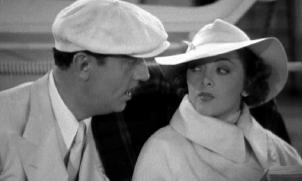
Bill Chandler (trying to get on Connie’s good side): I thought that was rather clever of me.
Connie Allenbury (who sees right through him): Yes, I thought you thought so.
Warren Haggerty: Would I ask you to do this thing for me if I didn’t consider you practically my wife?
Gladys: Would you ask your wife to hook up with that ape?
Bill Chandler: The ape objects.
Warren Haggerty (as the situation he has concocted begins to go awry): She may be his wife, but she’s engaged to me!
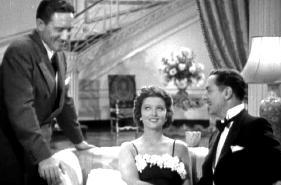
As always, I suppose you have to be there, and I recommend most heartedly that you do. The only displeasure that I might pass along to you is the ending, which wraps itself up far more quickly than I would have liked, with one major scene taking place off-screen, plus a couple of other events that are brought up in fast-paced fashion with nary a hint to the audience ahead of time that small gimmicks like this are going to be sprung upon them.
Otherwise, as I’ve previously suggested, a pure joy and delight.
« Previous Page — Next Page »
 RIDE LONESOME. Columbia Pictures, 1959. Randolph Scott, Karen Steele, Pernell Roberts, James Best, Lee Van Cleef, James Coburn. Screenwriter: Burt Kennedy; director: Budd Boetticher.
RIDE LONESOME. Columbia Pictures, 1959. Randolph Scott, Karen Steele, Pernell Roberts, James Best, Lee Van Cleef, James Coburn. Screenwriter: Burt Kennedy; director: Budd Boetticher.










